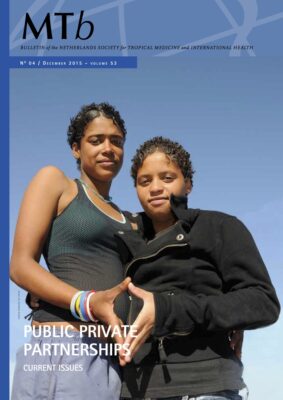
Public Private Partnerships
Editorial
Public-private partnerships are hot. Much is expected from private sector involvement in achieving the sustainable development goals (SDG). ‘The greatest political show on earth’, that is how the Guardian described the 70th UN General Assembly, held in September, at which 17 SDGs were adopted as successor to the MDGs. In the lead-up to this summit, the UN Secretariat launched Partnerships for SDG – an online platform to spur partnership engagement. It contains nearly 1,800 partnerships and initiatives promoting sustainable development. More than ever before, the private sector growth is embraced as a means for development and poverty reduction. Private sector development and PPPs are being portrayed as an alternative for development cooperation. Dutch Prime Minister Mark Rutte delivered a speech at the summit. He mentioned three lessons the MDG experience had taught us, one of which was ‘… we must have more private sector involvement in long-term financing, in public-private partnerships, and in projects on the ground. Dutch companies and the Dutch government already have a solid track record’. He cited Heineken and a couple of international initiatives in the domain of agribusiness and insurances. Also in September, our Minister of Foreign Trade & Development Cooperation, Lilianne Ploumen – you will note that the Development Cooperation part of her mandate comes second to Foreign Trade! – sent a letter to Parliament, outlining Dutch contributions to development and growth. Interestingly enough, efforts towards the promotion of sexual and reproductive health & rights are listed under the heading ‘Employment creation’. Strategic partnerships, under the programme ‘Samenspraak en Tegenspraak’ (Dialogue and Dissent), are considered essential to support civil society organisations in challenging governments on the inclusiveness aspect of their policies. The Minister’s action plan contains 20 actions, two of which are about access to medicines, the theme of the previous MTb edition. In October, we learned about Ploumen’s decision to allocate another € 10 million to the Health Insurance Fund, which introduced insurance schemes in Nigeria and some other African countries. This came on top of the initial € 100 million that former prime-minister Balkenende made available in 2007 – a demonstration of great faith and a powerful lobby! The programme is implemented by PharmAccess and supported by Achmea, Aegon, and several other Dutch multinationals. In this edition of MTb, we focus on Dutch involvement in PPPs in the context of international health. NVTG organised a session on PPPs at the ECTMIH conference in Basel last September. Three cases were presented, all of which had some kind of Dutch involvement: a female condom programme, the Health Insurance Fund, and an international initiative on drug development for neglected tropical diseases. You will find articles about these partnerships, which elaborate on the respective roles of public and private parties, their comparative advantages, and the challenges they face in working together. While there is an abundance of examples of governments and industry working together, or failing to do so, the evidence of what works and what doesn’t is rather anecdotal. Yet, people hold strong opinions about PPPs. Policy makers seem to embrace them, impressed as they are by lobbyists. Some scientists challenge them with empirical evidence . Practitioners may do likewise by sharing their experience with PPPs. What counts in the end is not whether we work together nicely, but whether we are successful in working collectively towards a legitimate public goal.
Leon Bijlmakers



















































